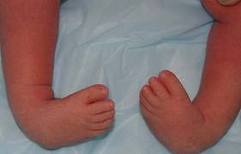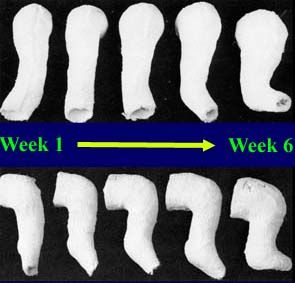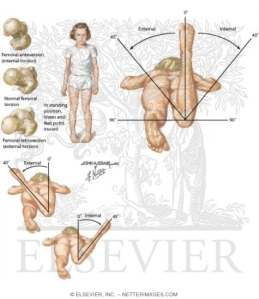bone
Congenital Talipes Equino Varus
1. Definition

Talipes = talus and pes/foot
Equino = Foot like horse (plantar flexi) position
Varus = heel varus, a decrease of the leg-foot angle
CTEV is a congenital deformity of one foot or both with description same as its abbreviation.
In Ad Equate = Inversion at subtalar joint, Adduction of tanonaviculare joint, Equino of ankle joint
2. Incidence
a. 1-2 in 1000 live births
b. Half the cases are bilateral
c. Boys are twice than girls
d. 10 % genetic factor and an initial mutation in the family tree
e. 1:4 chance probability for child who has one parent and one older sibling got clubfoot.
3. Etiology
Polygenic and multifactorial (speculation):
a. abnormal intrauterine forces
b. arrested fetal development
c. abnormal inserted muscle and tendon
d. abnormal rotation of talus in the mortise
e. germ plasm defects
4. Pathogenesis and pathology
a. Associated deformities are caused by shortened/contracted muscles, joint capsules, ligaments, and fascia.
b. Congenital dislocation (tallo, calcaneo, navicular joint)
c. Change of bone shape
d. The fibrous capsules of all the deformed joints are thick and contracted on concave side of the deformity. (contracture of soft tissue and congenital atresia)
5. Clinical features and diagnosis
a. General examination :
1) Other abnormalities : spina bifida, amyloplasia congenita
2) Syndrome Clubfoot : Larsen’s Syndrome, amniotic band syndrome
b. Characteristic examination :
1) Fore foot : adductus and supination
2) Hind foot : Equinus and varus
3) Tallar neck deformity : medial and plantar deviation
4) Calcaneus : medial rotation
5) Naviculare and cuboid : medial displacement
c. Radiographic diagnosis (for assessment of therapy progress as well)
1) From dorsoflexion lateral view : talocalcaneal angle < 35
2). From Anteroposterior view
a) Talocalcaneal angle <20 (normal 20-40)
b) Talo-first metatarsal angle negative ( normal 0-20)
3) Parallelism tallus-calcaneus is seen on both views
6. Treatment
a. Non surgery
Ponseti Method : < 6 months old
1) Serial (weekly) long leg plaster casts (6 weeks)
a) Correction of the cavus by aligning the first ray with remaining metatarsal
b) Lateral pressure on the distal talar head as a fulcrum to correct the fore foot adduction and heelvarus.
c) All deformities are correct gradually
2) Cast until there is about 60 degrees of external rotation (about 4-6 casts)
3) Percutaneous tendo Achilles tenotomy in cast room under local anesthesia, followed by final cast (3 weeks)
4) After final cast removal, apply Normal last shoes with Denis Browne bar set at 70 degrees external rotation (40 degrees on normal side)
5) Denis Browne splint full time for two months, then night time only for two-four years.
b. Surgery
1) 6-9 months. Surgical soft tissue release with tendon lengthening (be carefull with posterior tibial artery and dorsalis pedis artery)
2) 3-10 years. Medial opening or lateral column-shortening osteotomy or cuboideal osteotomy
3) 8-10 years. Triple arthrodesis is the only procedure possible to elaminating pain and deformity. Talectomy for insensate feet.
7. Prognosis
Depend on the age that the manipulation begin
The Ponseti method, if correctly done, is successful in >95% cases.
8. Complication
a. Contracted soft tissue fail to grow adequately in length produce limited production
b. Recurrence deformity (particularly during rapid skeletal growth period)
c. Complication of treatment : pressure necrosis of joint cartilage
Read Full Post | Make a Comment ( None so far )
Term describing deformities in limbs
1. Calcaneus and Equinus
a. Calcaneus is a deformity in which the foot is maintained in a position of dorsoflexion so that on weightbearing, only the heel touches the floor
b. Equinus is a deformity in which the foot is maintained in a position of plantar flexion so that on weightbearing, only the forefoot touches the floor
2. Cavus and planus
a. Pes cavus is an exaggeration of the normal longitudinal arch of the foot, an unduly high arch.
b. Pes planus is a diminution of the normal longitudinal arch of the fot, an unduly low arch
3. Internal torsion and external torsion
a. Internal torsion is the interior aspect of the distal end of the long bone is twisted inward or medially in relation to the anterior aspect of its proximal end.
b. External torsion is the anterior aspect of the distal end of the long bone is twisted outward or laterally in relation to the anterior aspect of its proximal end.
4. Anteversion and retroversion
It refers to the reationship between the neck of femur and the femoral shaft
a. Anteversion is when the knee is directed anteriorly, the femoral neck is directed anteriorly to some degree
b. Retroversion is when the knee is directed anteriorly, the femoral neck is directed posteriorly to some degree
5. Angulation or bowing deformities
6. Varus and valgus
The deformities of varus and valgus refer to abnormal angulation within a limb
a. Varus/ varum/ vara is an angulation that conforms to an imaginary circle in which the patient is placed. R= CIRCLE
b. Valgum / valgus/ valga is an angulation that does not conform to an imaginary circle in which the patient is placed. LG= not CIRCLE
(from Salter RB, Textbook of Disorders and Injuries of the Musculoskeletal System)
Read Full Post | Make a Comment ( None so far )Term describing movement of joints
1. Active and passive movement
a. Active : as a result of the individual’s own muscular activity
b. Passive : as a result of an external force
2. Abduction and adduction
a. Abduction : The movement of a part away from the midline of the body
b. Adduction : The movement of a part toward the midline of the body
3. Flexion and Extension
The movements occur at :
a. Elbow
b. Metacarpophalangeal
c. Interphalangeal (finger)
d. Knee
e. Interphalangeal (toe)
4. Dorsiflexion and plantar/palmar flexion
a. Dorsiflexion is the movement of the foot or toes in the direction of the dorsal surface as well as movement of the hand in the direction of the dorsal surface.
b. Plantarflexion is the movement of the foot or toes in the direction of the plantar surface
c. Palmarflexion is the movement of the hand or fingers in the direction of the palmar surface
5. Eversion and Inversion (at subtalar and midtalar joint of the foot)
 a. Eversion is the turning of the plantar surface of the foot outward in relation to the leg
a. Eversion is the turning of the plantar surface of the foot outward in relation to the leg
b. Inversion is the turning of the plantar surface of the foot inward in relation to the leg
6. Internal Rotation and external rotation (shoulder, hip, slight degree of knee)
a. Internal rotation is the turning of the anterior surface of the limb inward or medially
b. External rotation is the turning of the anterior surface of the limb outward or laterally
7. Pronation and supination (forearm through elbow and wrist and forefoot through midtarsal joint)
a. Pronation of forearm is the turning of the palmar surface of the hand downward
b. Supination of the forearm is the turning of the palmar surface of the and upward
c. Pronation of the foot usually refers to a deformity in which the forefoot is maintained in a position of eversion
d. Supination of the foot usually refers to a deformity in which the forefoot is maintained in a position of inversion
(from Salter RB, Textbook of Disorders and Injuries of the Musculoskeletal System)
Read Full Post | Make a Comment ( None so far )Reaction of Epiphyseal plates to disorders and injuries
1. Generalized reactions of all epiphyseal plate
a. Generalized increase in growth (gigantism)
1) Arachondactyly/ hyperchondroplasia/ Marfan’s Syndrome
2) Pituitary Gigantism
b. Generalized decrease in growth (dwarfism)
1) Achondroplasia
2) Pituitary dwarism (Lorain type)
3) Rickets
2. Localized reactions of an epiphyseal plate
a. Localized increase in growth
1) Chronic inflammation
2) Displaced fracture
3) Congenital Arteriovenous Malformations
b. Localized decrease in growth
1) Disuse retardation
2) Physical Injury
3) Thermal Injury
4) Ischemia
5) Infection
Read Full Post | Make a Comment ( None so far )Reaction of Bone to Disorders and Injuries
Four basic ways in which bone can react to abnormal conditions:
- Local death
- An alteration of bone deposition
- An alteration of bone resorption
- Mechanical failure
Reactions of living bone may be outlined as follows:
1. Altered deposition of bone
a) Increased deposition (increased formation of matrix with normal calsification)
b) Decreased deposition (either decreased formation of matrix or hypocalsification)
2. Altered resorption of bone
a) Increased resorption
b) Decreased resorption
3. Combinations of altered deposition and resorption of bone
Examples of Reactions of Living Bone
- Generalized Reactions as an organ
a) Bone deposition greater than bone resorption (generalized increase in bone)
(1) Osteopetrosis (Marble Bones)
(2) Acromegaly
b) Bone deposition less than bone resorption (generalized decrease in bone)
(1) Osteoporosis (Osteopenia)
(2) Rickets in Children and Osteomalacia in Adults
2. Localized reactions as a structure
a) Bone doposition greater than bone resorption (Localized increase in bone)
(1) Work Hypertrophy
(2) Degenerative Osteoartritis
(3) Fractures
(4) Infection
(5) Osteosclerotic Neoplasm
b) Bone deposition less than bone resorption (Localized decrease in bone)
(1) Disuse Atrophy (disuse osteoporosis)
(2) Rheumathoid Arthritis
(3) Infecton
(4) Osteolytic Neoplasm
(from Salter RB, Textbook of Disorders and Injuries of the Musculoskeletal System)
Read Full Post | Make a Comment ( None so far )Bone as structures and bone as an organ
Two different point of view of bone :
1. Individual bone are anatomical structure
2. Bone of entire skeleton collectively is a physiological organ (metabolically active)
As structures make enable them to serve three functions :
a. to provide the rigid framework for the trunk and extremities to withstand mechanical loads
b. to serve as levers for locomotor function of skeletal muscles
c. to afford protection for vulnerable viscera
As an organ serves two additional functions :
a. it contains hemopoetic tissue of the myeloid for the production of erythrocytes, granular leukocytes, and platelets
b. it is the organ of storage or reservoir for calcium, phosphorus, magnesium, and sodium
(from Salter RB. Textbook of Disorders and Injuries of The Musculoskeletal System)
Read Full Post | Make a Comment ( None so far )Hello world!
 This blog is dedicated to “Bone”. the Unique structure in which blood – our most important organ- is made. Strong but fragile, rigid but can heal itself.
This blog is dedicated to “Bone”. the Unique structure in which blood – our most important organ- is made. Strong but fragile, rigid but can heal itself.









